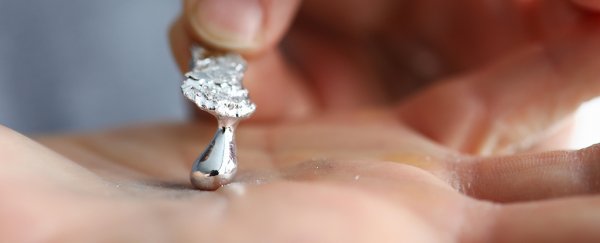Scientists have figured out how to make platinum more affordable as a catalyst: turn it into a low-temperature liquid.
It's been known for centuries that noble metals like platinum, gold, ruthenium, and palladium make excellent catalysts for chemical reactions, because they help break the chemical bonds between atoms more efficiently than other metals.
But noble metals are rare and expensive, so large-scale industrial manufacturers generally opt for cheaper, less effective alternatives like iron. (Iron is used as a catalyst in the mass production of fertilizer, for instance.)
The downside to using poorer quality catalysts is that chemical reactions must be heated up to high temperatures, which increases the carbon footprint for many industrial processes.
In a record-breaking achievement, researchers from UNSW Sydney and RMIT in Australia have dissolved platinum in liquid gallium, splitting the platinum atoms up so that there was more catalytic potential in a smaller amount of platinum.
Platinum normally has a melting temperature of 1,700 °C (3,092 Fahrenheit), which means it is usually a solid when used as a catalyst.
By infusing platinum into a gallium matrix, it adopts the melting point of gallium – a soft, silvery and non-toxic metal that melts basically at room temperature of 29.8 °C. One useful characteristic of liquid gallium is that it dissolves metals (like water dissolves salt and sugar) by separating the individual atoms in each molecule.
The invention has the potential to save on energy costs and lower emissions in industrial manufacturing, the researchers say.
"A range of important chemical reactions could be performed at relatively low temperature with the use of a more efficient catalyst like liquid platinum," lead author and chemical engineer Md. Arifur Rahim from UNSW Sydney told ScienceAlert.
Scientists have been trying to make expensive noble metal catalysts more affordable through a process of "miniaturization" since 2011, explains Rahim.
When metals are solid, only the atoms on the outside can be used in reactions, so there's a lot of waste. If you break this solid down into smaller and smaller clumps (think nanoparticles), you get a more efficient reaction as more metal atoms can muscle in – many hands make light work.
The most efficient and tiniest system would make each individual atom available to do the work of a catalyst.
"When you miniaturize the system, you're maximizing the surface-to-volume ratio and the atom utilization efficiency so that your overall consumption of the catalyst is smaller over time, and that can possibly make your product affordable," says Rahim.
"Theoretically, you get the maximum efficiency of that catalytic metal when it is at the atomic scale, because you cannot go beyond that."
In single-atom catalysts, the bonds holding the catalyst together are split and each atom is individually anchored in a substance called a matrix.
So, Rahim and colleagues tested gallium as their matrix. Once dissolved in gallium, they found that every platinum atom was split from every other platinum atom, making it a perfect miniature catalyst.
"When dissolved, platinum atoms are spatially dispersed in the liquid gallium matrix without atomic clustering (i.e., the absence of platinum-platinum bonding) that can drive different catalytic reactions with remarkable mass activity," the researchers write in their paper.
Platinum is mobile when it's in a liquid matrix, and much less prone to the problem of coking, where solid catalysts get covered in carbon and need to be cleaned before they can be reused.
Gallium isn't as cheap as iron. But it can be used again and again for the same reactions. This is because, like platinum, gallium doesn't get deactivated or degrade during the reaction.
The process of dissolving platinum in gallium requires raising the temperature to about 400 °C for a few hours. But it's a one-time investment of energy that saves further temperature hikes later during the chemical manufacturing process, the researchers say.
The team hopes their technique will lead to much cleaner and cheaper products, from fertilizer to green fuel cells.
The study was published in the journal Nature Chemistry.
